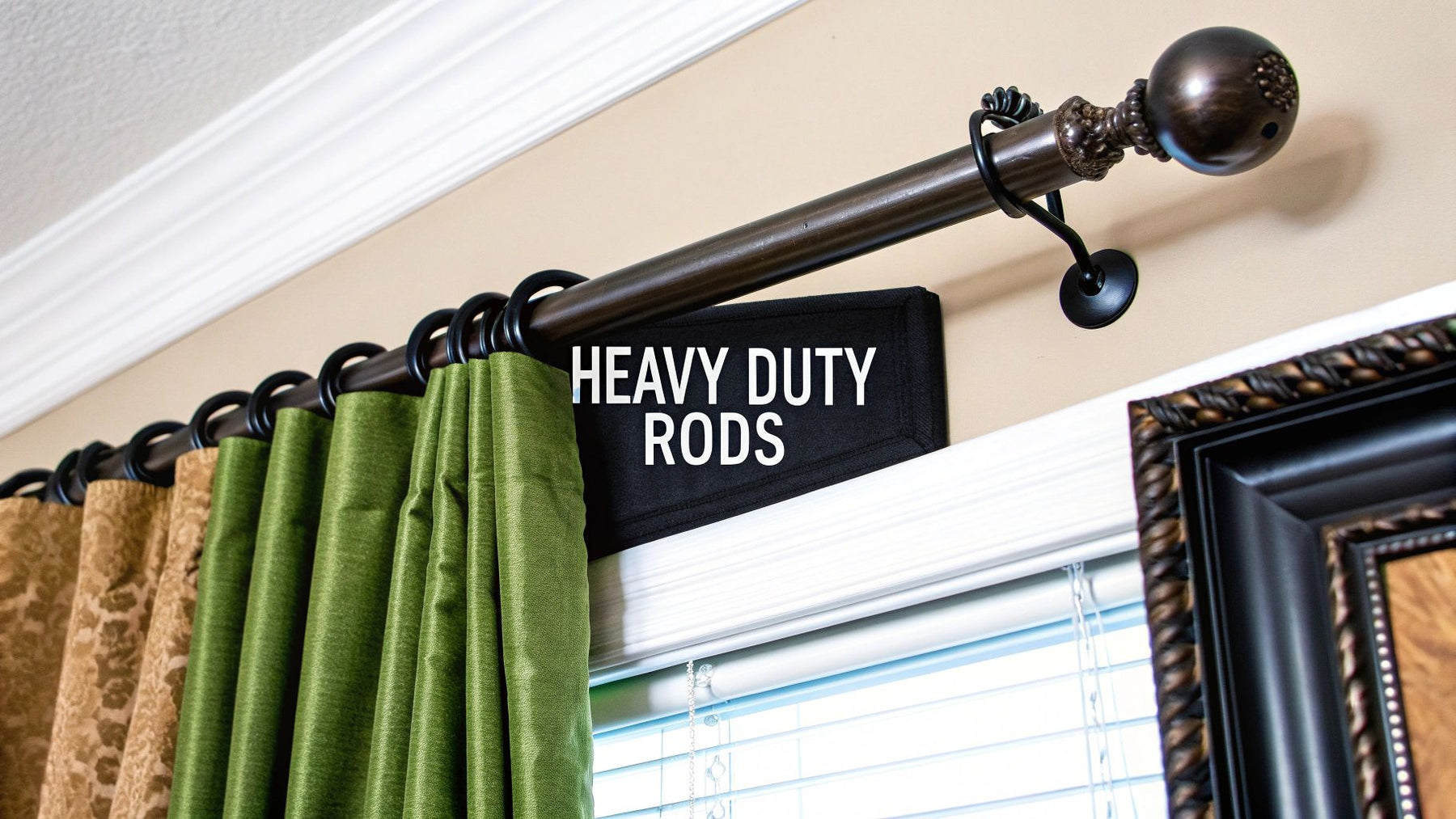
The Best Curtain Rods for Heavy Curtains: A 2024 Guide
The best curtain rods for heavy curtains are more than just hardware; they're the unsung heroes holding up your beautiful drapes. To do the job right, you need a rod made from a strong material like steel, with a diameter of at least one inch, and—this part is non-negotiable—a center support bracket to prevent that dreaded sag.
Think of it like this: using a standard, flimsy rod for heavy blackout or velvet drapes is like trying to hang a framed painting with a thumbtack. It might work for a minute, but gravity will always win. Investing in the right foundation ensures your window treatments look polished and stay securely on the wall.
Table of Contents
- Why Your Heavy Curtains Are Sagging (It's Not Your Fault!)
- Choosing the Right Rod: Material and Diameter Explained
- How to Calculate Your Curtain Weight (No Guessing Allowed)
- The Unsung Heroes: Why Brackets and Wall Anchors Matter Most
- A Practical Guide to Secure Installation
- Frequently Asked Questions
Why Your Heavy Curtains Are Sagging (It's Not Your Fault!)
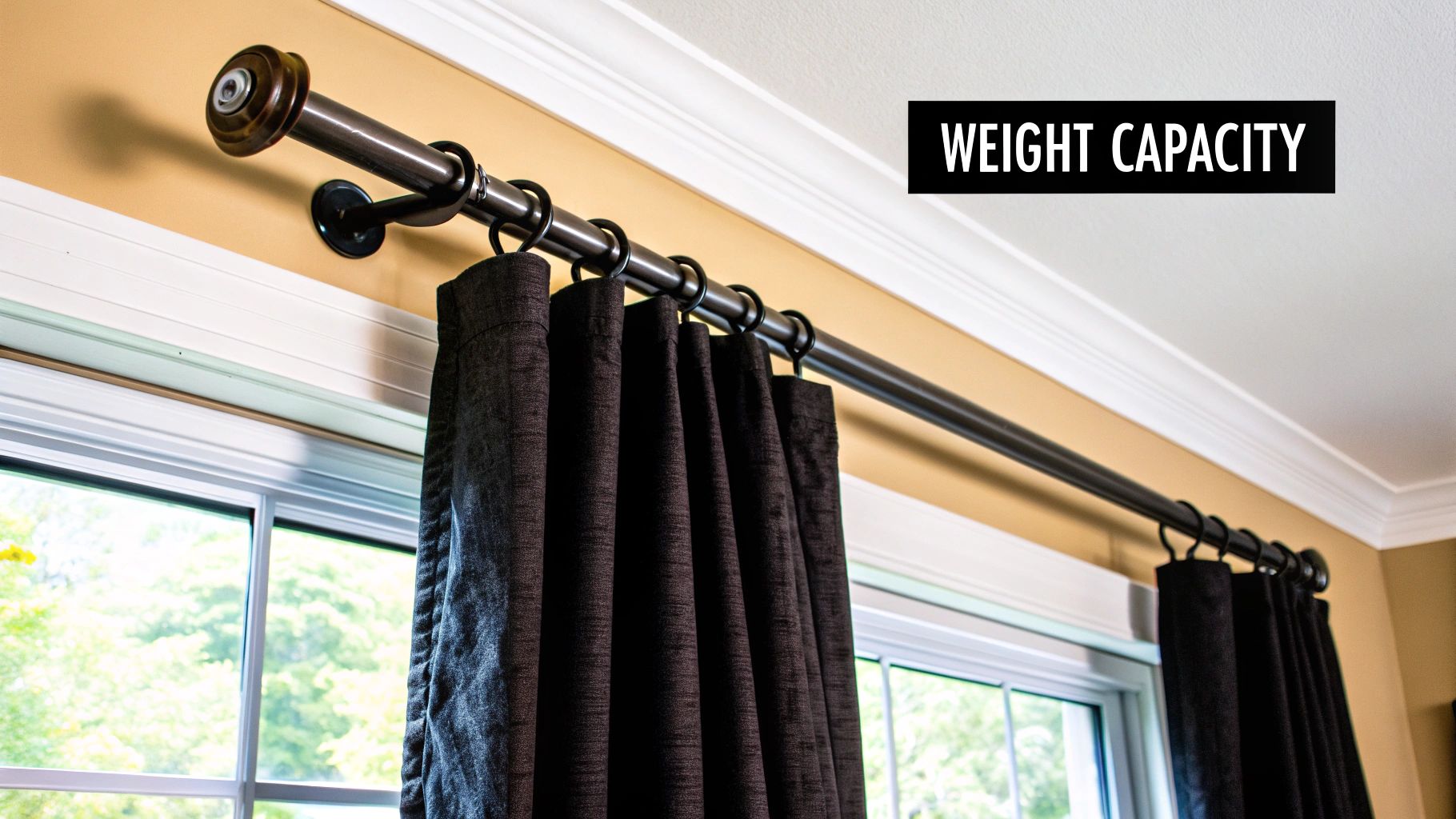
Alt text: A heavy white curtain hanging on a gold curtain rod, demonstrating the need for strong support.
If you've ever hung a gorgeous set of thermal curtains only to see the rod bowing a week later, you're not alone. It's a classic decor drama that almost always boils down to a simple mismatch: the curtain's weight versus the rod's strength.
Heavy curtains, which we love for their amazing light-blocking and insulating powers, are made from dense fabrics. A single panel can easily weigh between 10 to 25 pounds, meaning a pair can quickly overwhelm a standard, hollow metal rod.
The Anatomy of a Sagging Rod
So, what causes a curtain rod to sag? The frustrating droop you see is a textbook sign of hardware giving up under pressure. Standard rods often fail for a few key reasons:
- Weak Materials: Most basic rods are made from thin aluminum or hollow metal. While fine for sheer panels, they lack the structural integrity for serious weight.
- Skinny Diameter: A rod with a small diameter (3/4 inch or less) has very little internal strength and is far more likely to flex and bow.
- Lack of Support: Many kits only include two brackets. For any window wider than 48 inches, that's not enough to support heavy drapes, causing the middle to sag.
Key Takeaway: A sagging curtain rod isn't just an eyesore. It puts immense stress on your wall mounts, risking the whole setup pulling right out of the drywall.
The demand for better hardware is rising. The global drapery hardware market is expected to hit USD 8.79 billion by 2034, with curtain rods making up about 41% of the market. This trend shows that more of us are seeking quality decor that can handle beautiful, substantial fabrics.
You can learn more by checking out the full research on drapery hardware market trends. Ultimately, choosing the right curtain rods for heavy curtains from the start ensures your window treatments look fantastic and stay securely where they belong.
Choosing the Right Rod: Material and Diameter Explained
When hanging heavy curtains, two things matter more than anything: the rod's material and its diameter. Think of them as a team—one provides the backbone, the other the muscle. Getting this combination right is the secret to a professional, long-lasting look.
The rod's material is its foundational strength. While aesthetics are important, function has to come first with heavy drapes.
Picking the Right Material for Heavy Drapes
Different materials bring different levels of support and unique style. Steel and iron are the true heavyweights here, offering maximum durability for even the most luxurious velvet or blackout curtains. When paired with a proper diameter and enough support brackets, they are virtually sag-proof.
Solid wood offers a classic aesthetic and provides excellent strength, though it's a step down from steel. It’s a fantastic choice for moderately heavy fabrics like thick linen. Interestingly, some of the same principles for choosing heavy-duty clothes rails apply here—it's all about understanding robust design built to last.
Here’s a quick comparison to help you choose the best material for your needs.
Curtain Rod Material Strength Comparison
| Material | Strength & Durability | Best For | Aesthetic |
|---|---|---|---|
| Steel | Highest strength; resists sagging and bending under extreme weight. | Very heavy fabrics like velvet, thermal blackout curtains, or extra-wide drapes. | Modern, industrial, or minimalist. Can be finished in various colors. |
| Iron | Very high strength, similar to steel. Often features decorative, forged designs. | Heavy to very heavy curtains, especially for traditional or rustic styles. | Classic, rustic, traditional, wrought-iron looks. |
| Solid Wood | Good strength; can support moderately heavy drapes without issue. | Thick cotton, linen blends, and standard-weight lined curtains. | Warm, traditional, rustic, natural. Available in various stains and finishes. |
| Aluminum | Lightweight and rust-resistant, but lower strength. Not ideal for heavy loads. | Sheer, lightweight, or unlined cotton curtains. | Sleek, modern, and often used for track systems or contemporary designs. |
As you can see, steel is your safest bet for exceptionally heavy drapes, giving you total peace of mind.
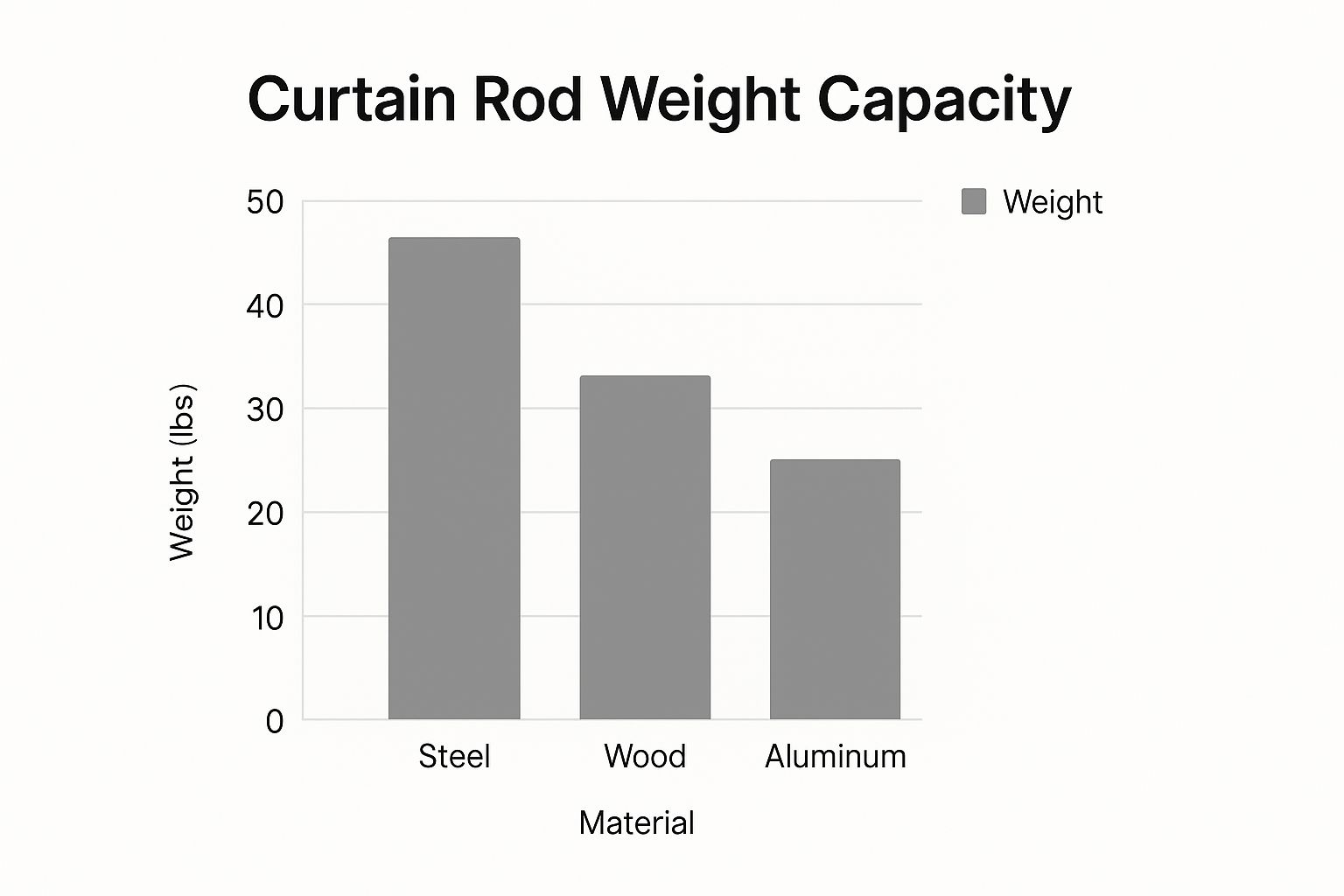
Why Diameter Makes a Huge Difference
What's the best diameter for a heavy-duty curtain rod? The short answer is at least one inch.
If the material is the backbone, the diameter is the muscle. A seemingly small increase in a rod's thickness dramatically boosts its ability to resist bending. A standard 3/4-inch rod might be fine for sheers, but it will quickly surrender to the weight of thermal drapes.
For very wide windows or exceptionally weighty fabrics, upgrading to a 1 1/8-inch or 1 1/4-inch diameter rod is a wise investment. This added thickness distributes the load much more effectively, preventing that dreaded sag in the middle.
Pro Tip: Whenever possible, choose a solid rod over a hollow one. While hollow rods are lighter and often cheaper, they lack the internal structure required to support significant weight without flexing.
How to Calculate Your Curtain Weight (No Guessing Allowed)
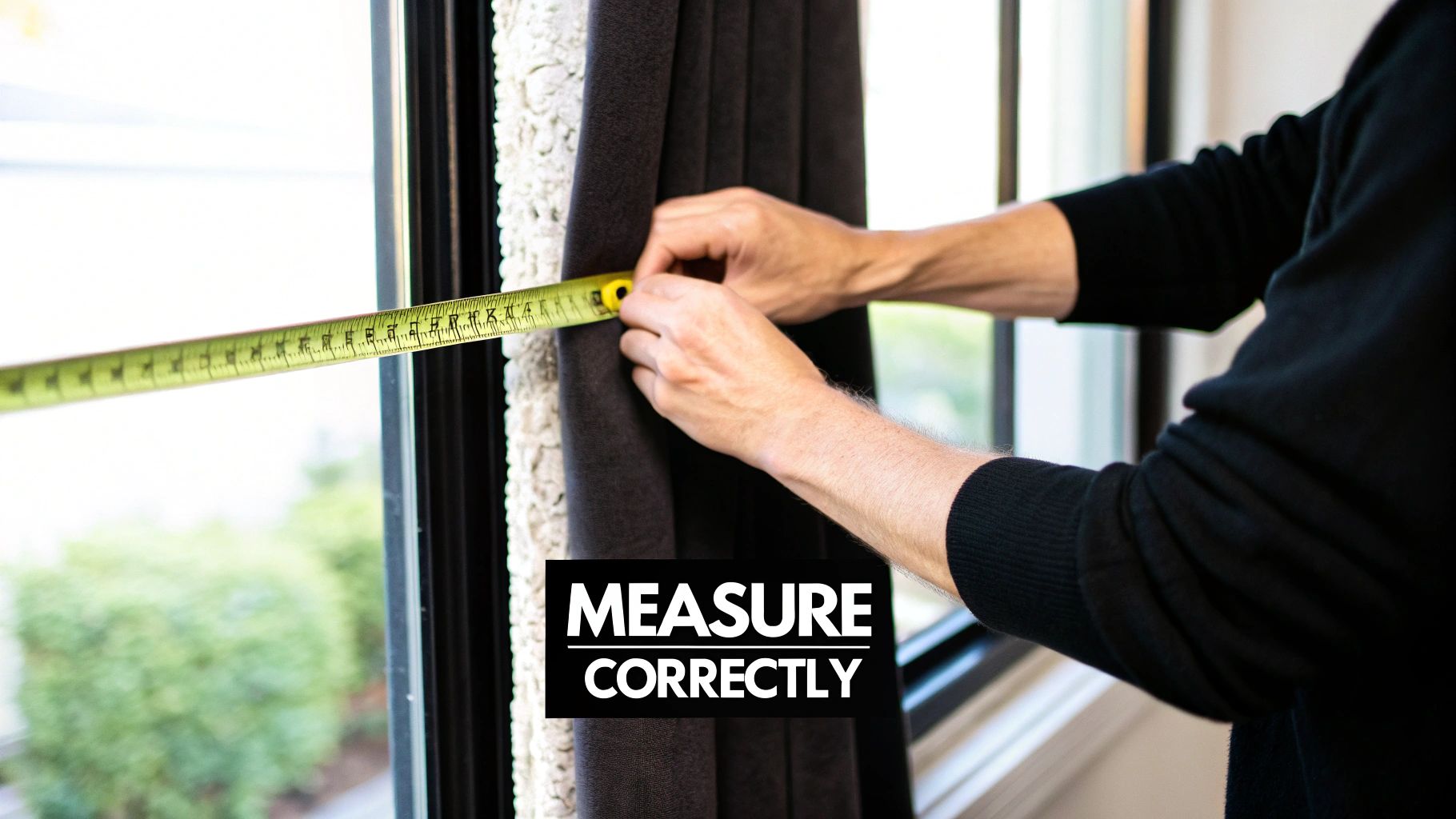
Guessing your curtain's weight is a recipe for disaster. Underestimating the load is the quickest way to end up with a bent rod or torn drywall.
Getting an accurate weight is simple, and it’s the most critical step to ensure your hardware holds up. The best tool for the job? A simple bathroom scale. It's a low-tech method that works perfectly.
The Foolproof Weighing Method
To get a precise total, gather everything you plan to hang from that single rod. We’re not just talking about the curtain panels; every little piece adds up.
Here’s a quick checklist of what to weigh together:
- All Curtain Panels: Whether you're hanging two panels or four, grab them all.
- Liners: If you're using separate blackout or thermal liners, include them.
- Hanging Hardware: Gather every single one of the curtain rings, clips, or pins you’ll be using.
Now for the easy part. Step on the scale by yourself and note your weight. Then, pick up the entire bundle of curtains and hardware, step back on the scale, and record that new number. The difference between the two figures is the true weight of your window treatment.
How to Read Manufacturer Weight Ratings
Once you have your total curtain weight, you can shop for rods. Manufacturers list a maximum weight capacity, but you should never aim to just meet this number. Think of it as a speed limit, not a target.
Expert Tip: I always recommend choosing a curtain rod rated to hold at least 25% more than your calculated curtain weight. This extra capacity builds in a crucial safety margin.
This buffer isn’t just for peace of mind. It accounts for the dynamic stress put on the rod every time you open and close your curtains. That daily pulling motion adds force that a maxed-out rod can't handle long-term, which leads to sagging and bracket failure.
Of course, weighing your curtains is only half the battle. Properly measuring your windows is just as important. Check out our guide on measuring windows for drapes to make sure you get it right.
The Unsung Heroes: Why Brackets and Wall Anchors Matter Most
You can have the strongest steel rod in the world, but it’s useless without the right support system holding it up. Your brackets and wall anchors are the unsung heroes of your window treatment; they’re doing the real heavy lifting.
The hardware that attaches the rod to the wall is what truly bears the weight. Skimping here is a common mistake that leads to sagging rods or, worse, the entire setup pulling out of the drywall. Those tiny plastic anchors included in many kits? They just aren't built for the demands of heavy fabric.
The Center Bracket Is Non-Negotiable
For any window wider than 48 inches, a center support bracket is an absolute must. Without it, even a solid 1-inch steel rod will eventually start to bow under the constant pressure from heavy drapes. Gravity always finds the weakest point, and that’s right in the middle.
Adding a third bracket (or even a fourth for an extra-wide window) distributes the total weight across multiple points instead of concentrating stress on the two ends. This simple addition is the single best way to prevent your rod from sagging.
A Pro Tip From Experience: Place your end brackets about 4-6 inches from the window frame. Install the center support bracket directly in the middle. For windows over 90 inches wide, I always use two evenly spaced center brackets for maximum, sag-free support.
Upgrading Your Anchors for Rock-Solid Security
Here’s a secret: the hardware that comes in the box is rarely your best option for heavy curtains. The ultimate goal is to screw at least one screw from each bracket directly into a wall stud—the vertical wood beams in your wall's frame. A stud finder is an inexpensive tool that will save you a world of headaches.
But what if there isn't a stud exactly where you need it? This is where you upgrade your anchors.
- Toggle Bolts: These are my go-to for hollow drywall. They have spring-loaded "wings" that open behind the wall, creating an incredibly strong anchor that can handle serious weight.
- Molly Bolts (Sleeve-Type Anchors): These work similarly, expanding behind the drywall to create a super secure hold.
Never rely on those small, plastic ribbed anchors for heavy drapes. They are designed for lightweight pictures and can easily pull out from the wall under constant strain. Spending a few extra dollars on heavy-duty anchors will give you priceless peace of mind.
A Practical Guide to Secure Installation
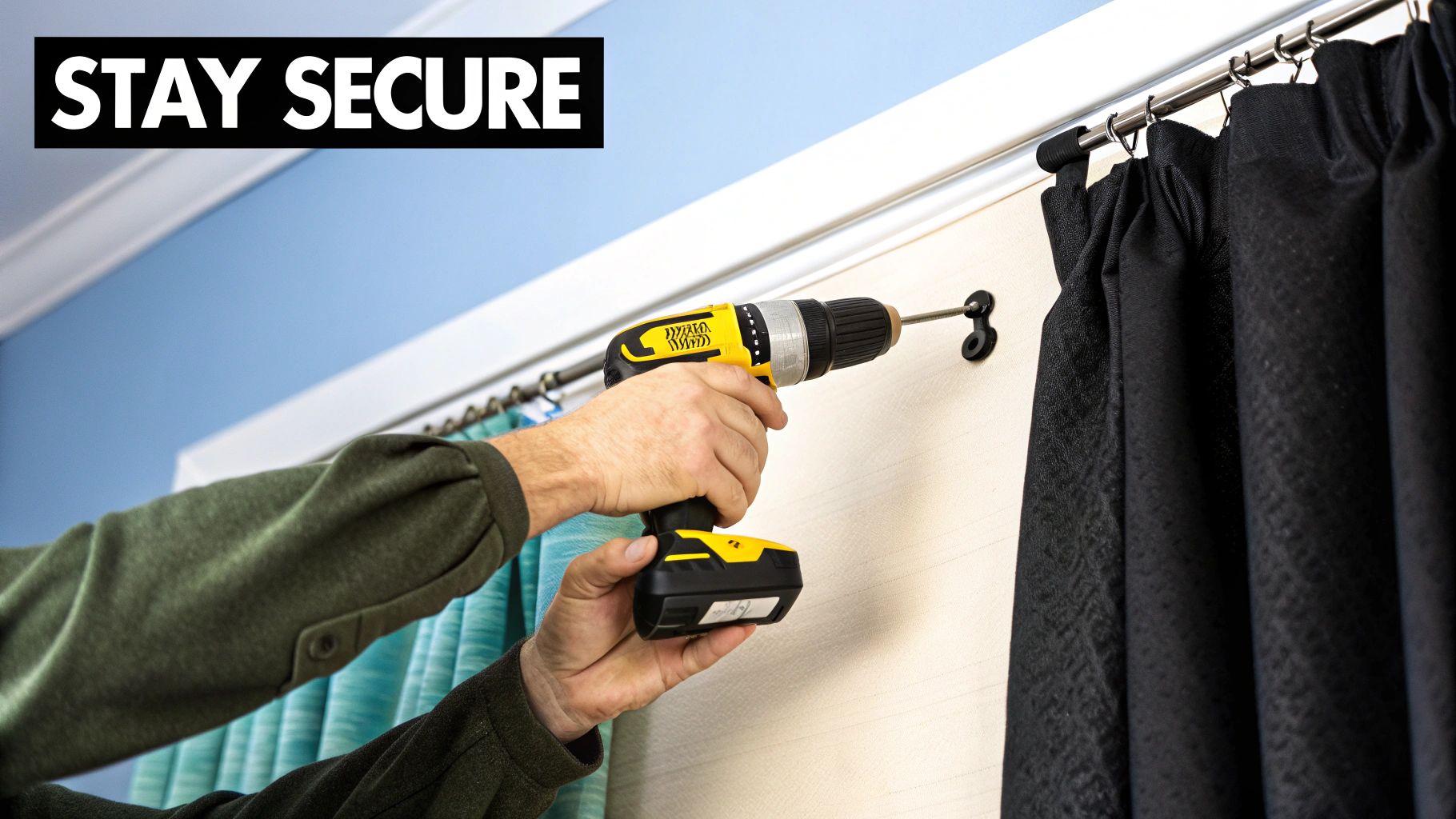
You've picked the perfect heavy-duty rod and brackets; now comes the most important part: getting it securely on the wall. A solid installation is what separates a professional window treatment from a saggy, frustrating mess.
You’re not alone in choosing more substantial window treatments. The market for home curtain rods was valued at around USD 2.5 billion in 2023 and is expected to hit USD 4.1 billion by 2032, showing more people are falling in love with luxurious, heavy curtains that require a robust installation.
Step 1: Find Your Anchor Points
The secret to a rock-solid installation is finding the wall studs. These vertical wooden beams offer the strongest possible anchor points for your brackets.
A simple electronic stud finder is your best friend. Slide it across the wall where you plan to hang the brackets, and it will beep or light up when it finds a stud. Mark the edges with a pencil. Your goal is to drive at least one screw from each bracket directly into a stud. Some expert DIY tips for installing building hardware can be a huge help here.
Step 2: Precision in Measurement and Placement
Once you know where your studs are, it's time to measure. Precision here ensures your curtains hang perfectly level.
- Height: Mount your brackets 4 to 6 inches above the window frame to create the illusion of a taller ceiling.
- Width: Place end brackets 3 to 6 inches wider than the window frame on each side. This lets you pull the curtains completely clear of the glass when open.
- Leveling: Use a laser level or a bubble level to draw a faint pencil line connecting your bracket marks, guaranteeing your rod will be perfectly horizontal.
Insider Tip: Always drill small pilot holes before driving in your screws, especially into a wood stud. This prevents the wood from splitting and helps the screw go in straight.
After your brackets are up, set the rod in place and do one last check with your level before hanging the curtains. Need a more detailed walkthrough? We have a complete guide on how to hang curtains properly.
Frequently Asked Questions
Even after doing your homework, a few questions always pop up when choosing and installing rods for heavy curtains. Let's tackle the most common ones.
How far should a curtain rod extend past the window?
As a rule of thumb, a curtain rod should extend 3 to 6 inches past the window frame on each side. For a bolder look or a very wide window, extending it up to 10 inches can look fantastic. This makes the window appear larger and allows more natural light in when the curtains are open.
Do heavy curtains need a center support bracket?
Yes, absolutely. If your window is wider than 48 inches, a center support bracket is non-negotiable for heavy curtains. Without one, even the toughest steel rod will eventually bow in the middle. For windows over 90 inches, using two evenly spaced center brackets provides maximum stability.
Can I use tension rods for heavy curtains?
No, you should not use tension rods for heavy curtains. The spring-loaded mechanism cannot handle the significant weight of blackout, thermal, or velvet drapes. Using one risks the rod slipping and falling, potentially damaging your wall or window frame. Always opt for a securely mounted rod with proper brackets.
Do the finials add a lot of weight?
Finials (the decorative end caps) add very little weight. Most are made from hollow metal, lightweight wood, or resin and are primarily for aesthetics. Their weight is negligible compared to the rod and heavy fabric panels, so you can choose the style you love without worrying about it overloading your setup.
Ready to give your beautiful drapes the strong, stylish foundation they deserve? Explore the collection of durable hardware at Joey'z Shopping. You'll find everything you need to support your heavy curtains at https://joeyzshopping.com.
